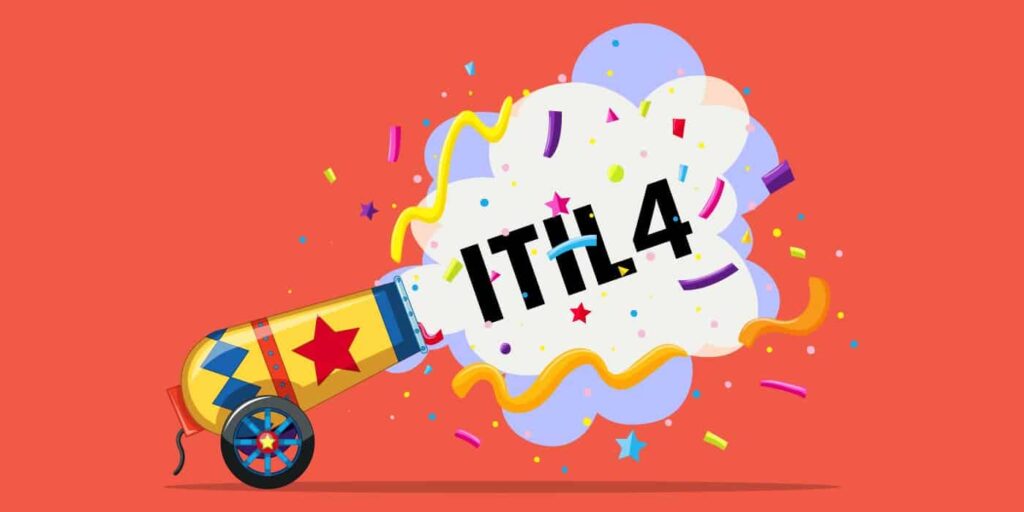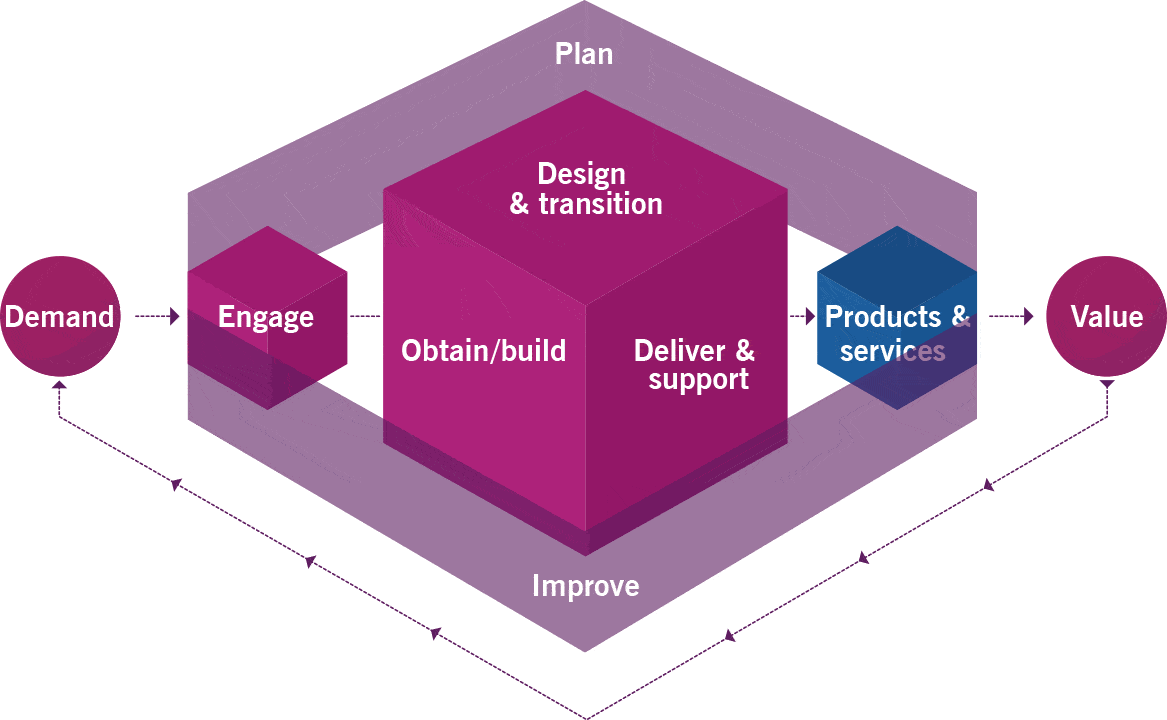Let’s talk about the ITIL 4 service value chain. The entire technology world is hopefully now aware that ITIL, the grand-daddy of all the IT service management (ITSM) frameworks, has morphed into ITIL 4. Taking over 30 years of service management experience, and a team of people I respect and I’m happy to call friends, to create something in the ITIL 4 service value chain that can be the framework to create better, faster, safer ways of benefiting from technology.
This ITIL 4 service value chain article is not a commentary on ITIL 4. I simply want to share how I was blown away by one ITIL 4 image while reviewing an e-course for ITIL 4 from ITSM Zone (shameless plug I know).
I wasn’t sure about this latest incarnation of ITIL until I saw the ITIL 4 service value chain image:
What Do You Observe?
Sherlock Holmes in a “Scandal in Bohemia” tells Watson: “You see, but you do not observe.” The same might be true with the ITIL 4 service value chain.
So please stop reading for a moment. Look at the ITIL 4 service value chain diagram. Observe and consider the impact of what it depicts against the way you deliver value with technology-based solutions at your organization today.
Are you blown away by the ITIL 4 service value chain? Please keep looking! Ask others what they think about the ITIL 4 service value chain!
ITIL 4 Service Value Chain – Demand
Does your demand flow like this: do this now, oh wait, not that but this, but could you do that by spending less and could we have it sooner? They DEMAND and you do what? It might be time to consider the ITIL 4 service value chain!
ITIL 4 Service Value Chain – Engage
Whoever encouraged the use of this word in the ITIL 4 service value chain model deserves an award!
They demanded and now you’ll engage to consider why they want this, how it will benefit them, and what has to occur next to meet their demand. Engage is the often-missing step in the ITIL 4 service value chain which needs to become mandatory.
Consider this: DevOps is about collaboration. Agile encourages people to work together to solve a problem. Lean suggests that to improve or deliver something, then people need to work together. VeriSM, which I played a small part in creating, encourages the interactions of everyone in the lifecycle of delivery – including suppliers – to play nicely in the demand mesh. ITIL 4 now underpins all of these practices, and others, with the use of the word “engage,” especially in the ITIL 4 service value chain.
ITIL 4 Service Value Chain – Plan and Improve
Some people see waterfall in the ITIL 4 service value chain. I observe one continuous process.
The ITIL 4 service value chain’s Plan and Improve: I try something, I learn from the outcome, and I improve. This activity encompasses the delivery lifecycle. It’s not something that occurs at the beginning and the end. I can drop it in anywhere I need to help remove a constraint that stops my capability to solve problems or enable solutions based on technology. How do I know I have a chance with my plan or in improving what I do? By engaging! It’s a key element of the ITIL 4 service value chain.
Obtain and Build – Design and Transition – Deliver and Support
Some people see waterfall in the ITIL 4 service value chain. I observe a constant set of activities. People engage to build something that’s based on an agreed design which when transitioned is affirmed by the people engaged to create or benefit from that Value.
All happy? Great then let’s deliver and support it no matter where it resides. Making people happy by providing things that are “right first time” is what engagement in the ITIL 4 service value chain is all about, especially in these digitally disruptive times.
ITIL 4 Service Value Chain – Deliver and Support
A further point on this aspect of the ITIL 4 service value chain. After four decades of supporting technology services for a variety of organizations, the one thing I’ve learned is that if you don’t engage on the way things will change or on how things need to be resolved if they break, then your service will always suffer.
Deliver and support in the ITIL 4 service value chain requires commitment from all involved parties. Technology services depend on your people but also on others. Treat them as suppliers and get what you pay for. Engage with them as partners and reap the rewards. Engage is a critical element of the service value chain.
Value = Products and Services
As written in many blogs and books: no matter what you do in your pipeline or technology lifecycle, or no matter how good and fast you are, it’s all a waste if what you deliver is of no use or poor quality. The same is true with the ITIL 4 service value chain.
Value is only perceived when that product or service is used and appreciated. You can’t determine this by sending out an occasional net promoter score (NPS) survey. You can only determine a product or service’s worth by engaging with the consumer, be they internal or external. It could be Ops building an API for product teams or your organization providing a new digital service – you can only know if it was of value by engaging as part of the ITIL 4 service value chain.
ITIL 4 Service Value Chain – Engage
Synonyms for the ITIL 4 service value chain’s engage: involve, participate, take part. This is what ITIL, no matter the version, has always been about. It’s not the processes or practices or tools that you use that matter. It’s the way you work together to create amazing things based on technology.
I won’t comment on the rest of ITIL 4, but I hope this encourages you to go and observe the ITIL 4 service value chain for yourself, and please engage with us on what you find!
If you have any helpful comments or opinions on the ITIL 4 service value chain, please share them in the comments section below. In fact, any comments on ITIL 4, and not just the ITIL service value chain, would be of interest to me and potentially to others. Let’s get a conversation going on the use of the ITIL 4 service value chain!
This 2019 ITIL 4 service value chain article was updated in 2023.
If you liked this ITIL 4 service value chain article, the following ITIL 4 articles are also very popular with ITSM.tools readers:
Daniel Breston
Daniel Breston is a 50+ year veteran of IT, ex-CIO and principle consultant, multiple framework trainer, blogger, and speaker. Daniel is on the board of itSMF UK and is a Fellow of the British Computer Society. Daniel may be retired, but he will help an organization if requested. Not full-time, but hey!



3 Responses
Quite an insightful read on the why and what of ITIL and how engaging it is on the service front..
“Blown away” ? By common sense and what organsiations (business leaders) have been doing for a long time, no. Good to see ITIL catching up but value chains have been around for a long time and shows how out of touch ITIL has been (or the contributors anyway). Too many ‘academia’ people involved who lack practical delivery and when we get that addressed we will have a framework anybody can use to guide them.
William, I couldn’t agree more. I have been doing “ITIL 4” with ITIL 3 for years, that is mixing it with concepts from Lean and Agile. I was using Stephen Covey’s “Seven Habits” as my guiding principles which gelled really well with my teams.
I’m an ITIL v2 Master so been adopting and adapting from the framework for a while now. My observation is that not much has really changed in ITIL at a practical level since then. Most orgs use the titles of the processes (now practices) and take little else from the books. They do Incident, Problem, Change etc. in title, making up their own way to do these with very little reference beyond Foundation level to the ITIL books. This being the case, the books could be at least a quarter the size they are now and probably have no negative impact on the uptake of ITIL practices. In fact, people would probably read them!
Lean and Agile, along with other guidance such as Cynefin, KCS, and KT provide the more practical “how to” more than ITIL ever has. ITIL 4 seems to be having mixed reviews, especially from the die hard Service Lifecycle crew, but I think it is a move in the right direction. But I’m yet to meet someone who has just finished their ITIL 4 Foundation training that understands how the pieces fit together. They just don’t get things like the PIEDOD is the what to do, the Practices the how to do it with the guiding principles and 4 dimensions at front of mind. I’m betting there will be an ITIL 4 2022 release ala ITIL v3’s 2011.